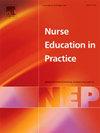心理声学学习方法与高保真模拟对护生心脏听诊能力的影响:随机对照研究
IF 4
3区 医学
Q1 NURSING
引用次数: 0
摘要
目的探讨心理声学学习方法和高保真模拟对护生心脏听诊能力的影响。背景:心脏听诊是护理专业学生的一项重要技能,但许多人努力发展熟练程度。基于模拟的培训已经成为一种潜在的解决方案,但不同模拟模式的有效性尚不清楚。设计:随机对照实验研究。方法52名 五年级护生随机分为心理声学学习组(n = 18)、高保真模拟组(n = 17)和对照组(n = 17)。通过三个时间点的成功测试来评估心脏听诊能力:测试前、测试后和随访(四周后)。干预后测量学习满意度和学习自信心。结果心理声学学习组心脏听诊评分从测试前到测试后及随访均有显著提高(p <; 0.05)。高保真模拟组从测试前到测试后均有改善(p <; 0.05),但在随访时无改善。对照组无明显变化。听诊评分组间差异无统计学意义(p >; 0.05),但高保真模拟的学习满意度(p = 0.013)和总量表评分(p = 0.017)高于心理声学学习。组间交互作用不显著(p = 0.547)。结论心理声学学习可提高中短期听诊技能,高保真模拟可提高短期听诊能力和学习满意度。将心理声学方法与模拟或传统教学相结合,可以提高可持续的学习效果,平衡效果、可及性和成本。本文章由计算机程序翻译,如有差异,请以英文原文为准。
The effect of psychoacoustic learning method and high-fidelity simulation on the cardiac auscultation competence of nursing students: A randomized controlled study
Aim
This study aimed to evaluate the effects of the psychoacoustic learning method and high-fidelity simulation on the cardiac auscultation competence of nursing students.
Background
Cardiac auscultation is a crucial skill for nursing students, yet many struggle to develop proficiency. Simulation-based training has emerged as a potential solution, but the effectiveness of different simulation modalities remains unclear.
Design
A randomized controlled experimental study.
Method
A total of 52 s-year nursing students were randomly assigned to one of three groups: psychoacoustic learning (n = 18), high-fidelity simulation (n = 17) and control (n = 17). Cardiac auscultation competence was assessed through a success test administered at three-time points: pre-test, post-test and follow-up (four weeks later). Learning satisfaction and self-confidence in learning were measured post-intervention.
Results
The psychoacoustic learning group significantly improved cardiac auscultation scores from pre-test to post-test and follow-up (p < 0.05). The high-fidelity simulation group improved from pre- to post-test (p < 0.05) but not at follow-up. The control group showed no significant changes. No significant between-group differences in auscultation scores (p > 0.05), but high-fidelity simulation had higher learning satisfaction (p = 0.013) and total scale scores (p = 0.017) than psychoacoustic learning. Group-time interaction was not significant (p = 0.547).
Conclusions
Psychoacoustic learning boosts short- and medium-term cardiac auscultation skills, while high-fidelity simulation enhances short-term performance and learning satisfaction. Combining psychoacoustic methods with simulation or traditional teaching may improve sustainable learning outcomes, balancing effectiveness, accessibility and cost.
求助全文
通过发布文献求助,成功后即可免费获取论文全文。
去求助
来源期刊

Nurse Education in Practice
NURSING-
CiteScore
5.40
自引率
9.40%
发文量
180
审稿时长
51 days
期刊介绍:
Nurse Education in Practice enables lecturers and practitioners to both share and disseminate evidence that demonstrates the actual practice of education as it is experienced in the realities of their respective work environments. It is supportive of new authors and will be at the forefront in publishing individual and collaborative papers that demonstrate the link between education and practice.
 求助内容:
求助内容: 应助结果提醒方式:
应助结果提醒方式:


